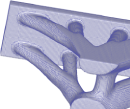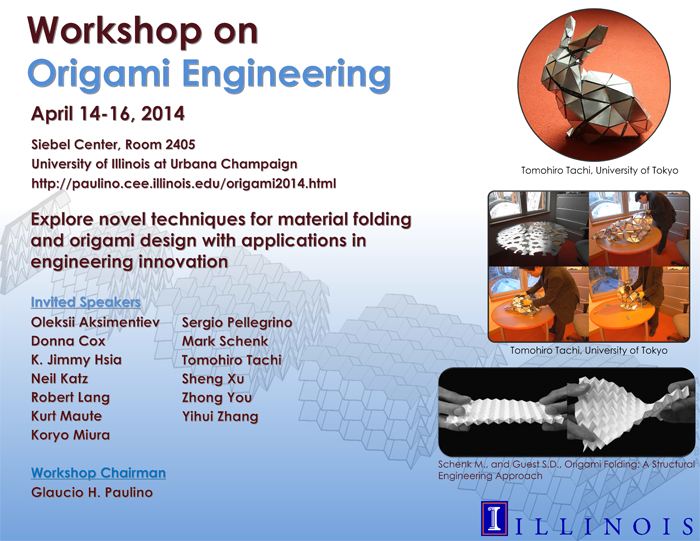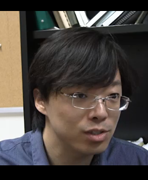Workshop on Origami Engineering
Welcome to the website for the Workshop on Origami Engineering!
University of Illinois at Urbana-Champaign
April 14-16, 2014
Jump to: Overview | Speakers and Abstracts | Guest Speakers | Schedule | Venue
University of Illinois at Urbana-Champaign
April 14-16, 2014
Jump to: Overview | Speakers and Abstracts | Guest Speakers | Schedule | Venue
This event is funded by the Civil and Environmental Engineering Department and the Computational Science and Engineering (CSE) Program at the University of Illinois at Urbana Champaign. This workshop is held as part of a investigative thrust to explore potential research directions in Origami Engineering.
The goal of this workshop is to recruit experts in art, science and engineering to discuss potential application of origami to real world engineering applications. The workshop will consist of brief lectures by all senior participants and will encourage discussion, interaction, and future collaboration.
Note: Before and after the workshop an origami art exhibition will be held in the Peoria Riverfront Museum (only 90 miles away). The exhibition entitled "Folding Paper: the Infinite Possibilities of Origami" would be of interest to workshop attendees. For more information view:
Peoria Riverfront Museum Website
Arts and Artists Website
The goal of this workshop is to recruit experts in art, science and engineering to discuss potential application of origami to real world engineering applications. The workshop will consist of brief lectures by all senior participants and will encourage discussion, interaction, and future collaboration.
Note: Before and after the workshop an origami art exhibition will be held in the Peoria Riverfront Museum (only 90 miles away). The exhibition entitled "Folding Paper: the Infinite Possibilities of Origami" would be of interest to workshop attendees. For more information view:
Peoria Riverfront Museum Website
Arts and Artists Website
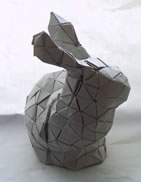
Paper bunny from Tachi’s Origamizer software
Oleksii Aksimentiev
Engineering DNA origami through microscopic simulations
The DNA origami method permits folding of long single-stranded DNA into complex three-dimensional structures with sub-nanometer precision. To ensure that such DNA origami objects behave exactly as designed, their structural, mechanical, and kinetic properties must be characterized at both macroscopic and microscopic scales. Transmission electron microscopy, atomic force microscopy and recently cryo-EM tomography have been used to characterize the properties of DNA origami objects, however their microscopic structures and dynamics have remained unknown. In this lecture, I will describe the results of all-atom molecular dynamics simulations that characterized the structural, mechanical and transport properties of DNA origami objects in unprecedented microscopic detail. Our work demonstrates the potential of all-atom molecular dynamics simulations to play a considerable role in future development of the DNA origami field by providing accurate, quantitative assessment of structural, mechanical and transport properties of DNA origami objects.
The DNA origami method permits folding of long single-stranded DNA into complex three-dimensional structures with sub-nanometer precision. To ensure that such DNA origami objects behave exactly as designed, their structural, mechanical, and kinetic properties must be characterized at both macroscopic and microscopic scales. Transmission electron microscopy, atomic force microscopy and recently cryo-EM tomography have been used to characterize the properties of DNA origami objects, however their microscopic structures and dynamics have remained unknown. In this lecture, I will describe the results of all-atom molecular dynamics simulations that characterized the structural, mechanical and transport properties of DNA origami objects in unprecedented microscopic detail. Our work demonstrates the potential of all-atom molecular dynamics simulations to play a considerable role in future development of the DNA origami field by providing accurate, quantitative assessment of structural, mechanical and transport properties of DNA origami objects.
About Oleksii Aksimentiev
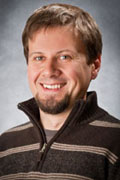
Oleksii Aksimentiev is an associate professor in physics at the University of Illinois at Urbana-Champaign. Dr. Aksimentiev has a background in soft matter physics and now deploys computational methods to investigate physical phenomena at the interface of solid-state nanodevices and biological macromolecules.
See website: http://bionano.physics.illinois.edu/

Oleksii Aksimentiev is an associate professor in physics at the University of Illinois at Urbana-Champaign. Dr. Aksimentiev has a background in soft matter physics and now deploys computational methods to investigate physical phenomena at the interface of solid-state nanodevices and biological macromolecules.
See website: http://bionano.physics.illinois.edu/
Donna Cox
The Art of Scientific Visualization
Donna Cox will provide a visual feast of unique scientific visualizations, arts-technology projects, IMAX movies, and museum shows from her collaborative work with interdisciplinary “Renaissance Teams” at the Advanced Visualization Laboratory (AVL) and Illinois eDream Institute (Emerging Digital Research and Education in Arts Media) at the National Center for Supercomputing Applications, University of Illinois at Urbana-Champaign.
Cox and her collaborators have thrilled millions of viewers with cinematic presentations of science. Her overview will include visualizations for large-scale public productions, digital full domes, museum exhibits, IMAX films, feature films, performing arts centers, and high-resolution television shows including work with the California Academy of Science, Denver Museum of Nature and Science, Fox Searchlight and IMAX Corporation. Cox’s presentation will include excerpts from the 'making of' the Hubble3D IMAX movie narrated by Leonardo DiCaprio. She and her collaborators used Hubble observational and cosmological data to create nearly one-fourth of the IMAX film that won the Giant Screen Awards for Best Film, Best Cinematography, and Best Life-long Learning. The AVL also works in a variety of scientific research projects, including interactive software for the U.S. Department of Transportation and Digital Cultural Heritage with the Cyprus Institute. Among the software and digital technologies, AVL’s Virtual Director™ holds a patent for virtual camera choreography and gestural interface design. AVL and eDream provide visualization software products for a variety of disciplines including the interactive performing arts.
At its broadest level, visualization makes the “invisible visible.” Cox and AVL make visible large-scale data and enable new understandings of natural phenomena to increase scientific literacies. They employ cinematic techniques to present these visualizations in public venues. She and the AVL team collaborate with professionals from a variety of disciplines to create and present visaphors, a term she coined to describe digital data-driven visual metaphors. She will focus on visaphors of computational data and the role that they play in an evolving new visual language. In current practice, researchers develop gather data and develop numerical models of scientific hypotheses. Computational and data-enabled sciences are paradigm shifts in the conduct of science where new knowledge is generated from investigators’ virtual laboratories. Scientists develop heuristic models of phenomena based on empirically derived data; then, together with visualization artists, they work to debug and reveal these studies generating massive blocks of numerical information. This emerging method of inquiry depends upon data visualization to provide insight. Cox will enlighten the audience with a range of dynamic animated visuals including supernova explosions, hurricane evolution, and Chicago traffic
Donna Cox will provide a visual feast of unique scientific visualizations, arts-technology projects, IMAX movies, and museum shows from her collaborative work with interdisciplinary “Renaissance Teams” at the Advanced Visualization Laboratory (AVL) and Illinois eDream Institute (Emerging Digital Research and Education in Arts Media) at the National Center for Supercomputing Applications, University of Illinois at Urbana-Champaign.
Cox and her collaborators have thrilled millions of viewers with cinematic presentations of science. Her overview will include visualizations for large-scale public productions, digital full domes, museum exhibits, IMAX films, feature films, performing arts centers, and high-resolution television shows including work with the California Academy of Science, Denver Museum of Nature and Science, Fox Searchlight and IMAX Corporation. Cox’s presentation will include excerpts from the 'making of' the Hubble3D IMAX movie narrated by Leonardo DiCaprio. She and her collaborators used Hubble observational and cosmological data to create nearly one-fourth of the IMAX film that won the Giant Screen Awards for Best Film, Best Cinematography, and Best Life-long Learning. The AVL also works in a variety of scientific research projects, including interactive software for the U.S. Department of Transportation and Digital Cultural Heritage with the Cyprus Institute. Among the software and digital technologies, AVL’s Virtual Director™ holds a patent for virtual camera choreography and gestural interface design. AVL and eDream provide visualization software products for a variety of disciplines including the interactive performing arts.
At its broadest level, visualization makes the “invisible visible.” Cox and AVL make visible large-scale data and enable new understandings of natural phenomena to increase scientific literacies. They employ cinematic techniques to present these visualizations in public venues. She and the AVL team collaborate with professionals from a variety of disciplines to create and present visaphors, a term she coined to describe digital data-driven visual metaphors. She will focus on visaphors of computational data and the role that they play in an evolving new visual language. In current practice, researchers develop gather data and develop numerical models of scientific hypotheses. Computational and data-enabled sciences are paradigm shifts in the conduct of science where new knowledge is generated from investigators’ virtual laboratories. Scientists develop heuristic models of phenomena based on empirically derived data; then, together with visualization artists, they work to debug and reveal these studies generating massive blocks of numerical information. This emerging method of inquiry depends upon data visualization to provide insight. Cox will enlighten the audience with a range of dynamic animated visuals including supernova explosions, hurricane evolution, and Chicago traffic
About Donna Cox
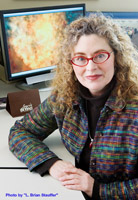
Donna J. Cox, MFA, PhD, is the University of Illinois’s first Michael Aiken Chair, Director of the Advanced Visualization Laboratory (AVL) at the National Center for Supercomputing Applications, Director of the Illinois Emerging Digital Research and Education in Arts Media Institute (eDream), and Professor in the School of Art and Design at the College of Fine and Applied Arts. She is a recognized pioneer in scientific visualization for public outreach and education and originator of the collaborative model of Renaissance Teams and the concept of visaphors (digital metaphors of computational science).
See website: http://avl.ncsa.illinois.edu/who-we-are/team/donna-cox-director

Donna J. Cox, MFA, PhD, is the University of Illinois’s first Michael Aiken Chair, Director of the Advanced Visualization Laboratory (AVL) at the National Center for Supercomputing Applications, Director of the Illinois Emerging Digital Research and Education in Arts Media Institute (eDream), and Professor in the School of Art and Design at the College of Fine and Applied Arts. She is a recognized pioneer in scientific visualization for public outreach and education and originator of the collaborative model of Renaissance Teams and the concept of visaphors (digital metaphors of computational science).
See website: http://avl.ncsa.illinois.edu/who-we-are/team/donna-cox-director
K. Jimmy Hsia
3D Curvilinear Shape Formation through 2D Engineering at Nanoscale
Self-assembly of 3D curvilinear shapes can be induced by various driving forces, including capillary interactions and mismatch/residual strains. As the characteristic dimensions of structures and devices become smaller, the surface to volume ratio in these components increases significantly. Consequently, surface phenomena become increasingly important. In this presentation, I will use several particular case studies to demonstrate that interesting mechanical phenomena exist in 3D shape formation from 2D nanoscale thin films. These case studies include the self-assembling process of 3D photovoltaic devices made of thin silicon foil (cover article in Dec 2009 issue of PNAS), folding of polymer films by differential swelling, and formation of semiconductor nanotube arrays by mismatch strain. Modeling of these systems shows that critical parameters emerge naturally. These parameters may be used to guide the fabrication and manufacturing of nanoscale components.
Self-assembly of 3D curvilinear shapes can be induced by various driving forces, including capillary interactions and mismatch/residual strains. As the characteristic dimensions of structures and devices become smaller, the surface to volume ratio in these components increases significantly. Consequently, surface phenomena become increasingly important. In this presentation, I will use several particular case studies to demonstrate that interesting mechanical phenomena exist in 3D shape formation from 2D nanoscale thin films. These case studies include the self-assembling process of 3D photovoltaic devices made of thin silicon foil (cover article in Dec 2009 issue of PNAS), folding of polymer films by differential swelling, and formation of semiconductor nanotube arrays by mismatch strain. Modeling of these systems shows that critical parameters emerge naturally. These parameters may be used to guide the fabrication and manufacturing of nanoscale components.
About K. Jimmy Hsia
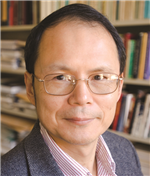
K. Jimmy Hsia is Professor of Mechanical Science and Engineering at the University of Illinois at Urbana-Champaign (UIUC). He is a solid mechanician by training. His research interests include deformation and failure mechanisms of materials, mciro/nanomechanics of nanoscale materials, and, recently, cell mechanics.

K. Jimmy Hsia is Professor of Mechanical Science and Engineering at the University of Illinois at Urbana-Champaign (UIUC). He is a solid mechanician by training. His research interests include deformation and failure mechanisms of materials, mciro/nanomechanics of nanoscale materials, and, recently, cell mechanics.
Neil Katz
Origami and Architecture
Origami has traditionally been an art form practiced at a ‘finger’ scale and with materials appropriate to creating forms with one’s hands. Recent developments in practical applications of origami structures have looked at taking them from this meso scale to the micro scale. In this presentation, we explore potential applications of origami structures at the macro scale useful in architecture and interior design. The presentation will review work already underway in this area, and will discuss potential future applications of building-scale and furniture-scale origami, from the perspective of the practicing architect and engineer.
Topics will address the possibilities and benefits of origami-inspired and actual origami structures from a variety of points-of-view, including:
Origami has traditionally been an art form practiced at a ‘finger’ scale and with materials appropriate to creating forms with one’s hands. Recent developments in practical applications of origami structures have looked at taking them from this meso scale to the micro scale. In this presentation, we explore potential applications of origami structures at the macro scale useful in architecture and interior design. The presentation will review work already underway in this area, and will discuss potential future applications of building-scale and furniture-scale origami, from the perspective of the practicing architect and engineer.
Topics will address the possibilities and benefits of origami-inspired and actual origami structures from a variety of points-of-view, including:
- new design possibilities
- comparison of origami solutions to convention solutions
- fabrication and component transportation
- structural engineering challenges
- environmental considerations
About Neil Katz
Neil Katz is an architect with Skidmore, Owings and Merrill. He uses a "computational design" approach to design, and has used this methodology in developing geometry (simple and "complex" geometry) and as a way of analyzing and designing in response to many project goals, including environmental and sustainability goals.
"Computational design", aspects of which include algorithmic and parametric design as well as building information modeling (BIM), is as much a way of thinking about design as using and developing tools for design.
Neil has taught at various schools, and is often invited to speak about his work at schools and conferences.
Neil Katz is an architect with Skidmore, Owings and Merrill. He uses a "computational design" approach to design, and has used this methodology in developing geometry (simple and "complex" geometry) and as a way of analyzing and designing in response to many project goals, including environmental and sustainability goals.
"Computational design", aspects of which include algorithmic and parametric design as well as building information modeling (BIM), is as much a way of thinking about design as using and developing tools for design.
Neil has taught at various schools, and is often invited to speak about his work at schools and conferences.
Robert Lang
From Flapping Birds to Space Telescopes: The Art and Science of Origami
The last decade of this past century has been witness to a revolution in the development and application of mathematical techniques to origami, the centuries-old Japanese art of paper-folding. The techniques used in mathematical origami design range from the abstruse to the highly approachable. In this talk, I will describe how geometric concepts led to the solution of a broad class of origami folding problems – specifically, the problem of efficiently folding a shape with an arbitrary number and arrangement of flaps, and along the way, enabled origami designs of mind-blowing complexity and realism, some of which you’ll see, too. As often happens in mathematics, theory originally developed for its own sake has led to some surprising practical applications. The algorithms and theorems of origami design have shed light on long-standing mathematical questions and have solved practical engineering problems. I will discuss examples of how origami has enabled safer airbags, Brobdingnagian space telescopes, and more.
The last decade of this past century has been witness to a revolution in the development and application of mathematical techniques to origami, the centuries-old Japanese art of paper-folding. The techniques used in mathematical origami design range from the abstruse to the highly approachable. In this talk, I will describe how geometric concepts led to the solution of a broad class of origami folding problems – specifically, the problem of efficiently folding a shape with an arbitrary number and arrangement of flaps, and along the way, enabled origami designs of mind-blowing complexity and realism, some of which you’ll see, too. As often happens in mathematics, theory originally developed for its own sake has led to some surprising practical applications. The algorithms and theorems of origami design have shed light on long-standing mathematical questions and have solved practical engineering problems. I will discuss examples of how origami has enabled safer airbags, Brobdingnagian space telescopes, and more.
About Robert Lang
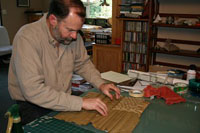

Robert J. Lang is recognized as one of the foremost origami artists in the world as well as
a pioneer in computational origami and the development of formal design algorithms for
folding. With a Ph.D. in Applied Physics from Caltech, he has, during the course of work
at NASA/Jet Propulsion Laboratory, Spectra Diode Laboratories, and JDS Uniphase,
authored or co-authored over 100 papers and 50 patents in lasers and optoelectronics as
well as authoring, co-authoring, or editing 14 books and a CD-ROM on origami. He is
a full-time artist and consultant on origami and its applications to engineering problems
but keeps his toes in the world of lasers, most recently as the Editor-in-Chief of the IEEE
Journal of Quantum Electronics from 2007–2010. He received Caltech’s highest honor,
the Distinguished Alumni Award, in 2009 and was elected a Fellow of the American
Mathematical Society in 2013.
See website: http://www.langorigami.com/
See website: http://www.langorigami.com/
Kurt Maute
Origami Design Enabled by Active Polymers
Origami design principles allow creating complex three-dimensional structures from a single sheet of paper through folding. The simplicity of this setup renders origami design an appealing concept across a broad range of length scales. However, in addition to carefully designing the crease patterns, the folding process requires a great level of dexterity, if done manually, or sophisticated robotics. The challenges of the folding process increase as the length scale decreases. Utilizing active materials in origami design is an appealing approach, in particular at small length scales.
In this talk, we present an overview of material systems and design approaches suitable to create and actuate folds in initially flat substrates. Typically, these material systems contain active material components which either deform and develop actuation forces upon external stimuli or change their stiffness on demand, triggering deformations due to pre-strain in other material components. Here, we focus on active polymers as they allow tailoring the material system to a particular application. A broad range of stimuli and actuation mechanisms are available, such as thermal, chemical, and optical. Further, the properties of the polymer can be radically changed after the folding sequence is completed, e.g. the stiffness of the material components can be increased.
In the design of origami structures with active materials, the specific characteristics of deformation and actuation force generation, the temporal and spatial control of the stimuli, and the mechanical response of the entire structure need to be carefully considered. To this, end we present a modeling framework which models various actuation mechanisms via generalized eigenstrains and accounts for finite strains and large displacements. To determine the crease patterns, a topology optimization approach is adopted. The potential of utilizing active materials for the design of origami structures is demonstrated with selected examples, which are studied both experimentally and numerically.
Origami design principles allow creating complex three-dimensional structures from a single sheet of paper through folding. The simplicity of this setup renders origami design an appealing concept across a broad range of length scales. However, in addition to carefully designing the crease patterns, the folding process requires a great level of dexterity, if done manually, or sophisticated robotics. The challenges of the folding process increase as the length scale decreases. Utilizing active materials in origami design is an appealing approach, in particular at small length scales.
In this talk, we present an overview of material systems and design approaches suitable to create and actuate folds in initially flat substrates. Typically, these material systems contain active material components which either deform and develop actuation forces upon external stimuli or change their stiffness on demand, triggering deformations due to pre-strain in other material components. Here, we focus on active polymers as they allow tailoring the material system to a particular application. A broad range of stimuli and actuation mechanisms are available, such as thermal, chemical, and optical. Further, the properties of the polymer can be radically changed after the folding sequence is completed, e.g. the stiffness of the material components can be increased.
In the design of origami structures with active materials, the specific characteristics of deformation and actuation force generation, the temporal and spatial control of the stimuli, and the mechanical response of the entire structure need to be carefully considered. To this, end we present a modeling framework which models various actuation mechanisms via generalized eigenstrains and accounts for finite strains and large displacements. To determine the crease patterns, a topology optimization approach is adopted. The potential of utilizing active materials for the design of origami structures is demonstrated with selected examples, which are studied both experimentally and numerically.
About Kurt Maute
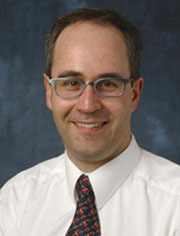
Kurt Maute is the Joseph Negler Professor of Aerospace Engineering Sciences and Associate Dean for Reach at the University of Colorado, Boulder. His research interests include structural topology and shape optimization, multidisciplinary optimization, optimization of aeroelastic systems, adaptive discretization methods in structural optimization, and optimization of materially nonlinear structures.
See website: http://www.colorado.edu/aerospacestructures/people/kurt-maute

Kurt Maute is the Joseph Negler Professor of Aerospace Engineering Sciences and Associate Dean for Reach at the University of Colorado, Boulder. His research interests include structural topology and shape optimization, multidisciplinary optimization, optimization of aeroelastic systems, adaptive discretization methods in structural optimization, and optimization of materially nonlinear structures.
See website: http://www.colorado.edu/aerospacestructures/people/kurt-maute
Koryo Miura
The way from shell buckling to Miura-ori
The notorious problem of buckling of thin cylindrical shell was finally solved with the assumption of “in-extensional deformation”, proposed by Y. Yoshimura. The resulting polyhedral surface is now called Yoshimura-pattern. It is to be noted that the in-extensional deformation is certainly the basic property of origami that is our present subject.
Inspired with the Yoshimura pattern, I have challenged the problem of buckling of a thin infinite plate under external contraction. I imagined that, under less constraint boundary conditions, a pseudo problem of packaging a thin sheet of film into a point can be solved. Without doubt, the possible solution should have the property of in-extensional deformation. Or, it should be realized with origami models. Soon after the start of this study, I had arrived at a simple origami model that fulfils all of relevant conditions and is mathematically elegant. Then, I was confident of the result and started the verification phase of the study.
However, I faced to a tough barrier of bureaucracy instead of technical difficulty. In the 1970’s, using a super computer for studying origami was not easily justified even if at the prominent space institute, ISAS. Finally, with the elaborate effort of K. Tanizawa, we had completed the computational verification. Ironically, the first application of the concept was the 2-Dimensional Solar Array Experiment on the Japanese satellite by ISAS, 1995~6.
*To support this presentation, some old origami models used for this study will be shown.
The notorious problem of buckling of thin cylindrical shell was finally solved with the assumption of “in-extensional deformation”, proposed by Y. Yoshimura. The resulting polyhedral surface is now called Yoshimura-pattern. It is to be noted that the in-extensional deformation is certainly the basic property of origami that is our present subject.
Inspired with the Yoshimura pattern, I have challenged the problem of buckling of a thin infinite plate under external contraction. I imagined that, under less constraint boundary conditions, a pseudo problem of packaging a thin sheet of film into a point can be solved. Without doubt, the possible solution should have the property of in-extensional deformation. Or, it should be realized with origami models. Soon after the start of this study, I had arrived at a simple origami model that fulfils all of relevant conditions and is mathematically elegant. Then, I was confident of the result and started the verification phase of the study.
However, I faced to a tough barrier of bureaucracy instead of technical difficulty. In the 1970’s, using a super computer for studying origami was not easily justified even if at the prominent space institute, ISAS. Finally, with the elaborate effort of K. Tanizawa, we had completed the computational verification. Ironically, the first application of the concept was the 2-Dimensional Solar Array Experiment on the Japanese satellite by ISAS, 1995~6.
*To support this presentation, some old origami models used for this study will be shown.
About Koryo Miura
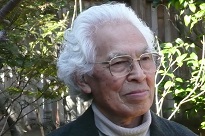
Koryo Miura is a Professor Emeritus at the University of Tokyo and Inst. Space & Astronautical Science. He was also a Resident Research Associate at NASA Langley Research Center (1966~67) and an honorary member of the International Association for Shell & Spatial Structures.
He is also the president of the upcoming 6th International Meeting of Origami in Science, Mathematics and Education to be held in Tokyo, August 10~13, 2014.

Koryo Miura is a Professor Emeritus at the University of Tokyo and Inst. Space & Astronautical Science. He was also a Resident Research Associate at NASA Langley Research Center (1966~67) and an honorary member of the International Association for Shell & Spatial Structures.
He is also the president of the upcoming 6th International Meeting of Origami in Science, Mathematics and Education to be held in Tokyo, August 10~13, 2014.
Sergio Pellegrino
High-Fidelity Simulations of Origami Structures: Applications to Retinal Implants
We consider physical realizations of origami crease patterns in thin linear-elastic films, where each crease has finite width and thickness. The folding process is simulated with the ABAQUS finite element code and, through a combination of implicit and quasi-static explicit analyses with carefully tuned simulation parameters, we are able to compute complex folded shapes. These techniques have been applied to the design of novel retinal implants with distributed microelectronics that are able to conform very accurately to retinas of different shapes.
We consider physical realizations of origami crease patterns in thin linear-elastic films, where each crease has finite width and thickness. The folding process is simulated with the ABAQUS finite element code and, through a combination of implicit and quasi-static explicit analyses with carefully tuned simulation parameters, we are able to compute complex folded shapes. These techniques have been applied to the design of novel retinal implants with distributed microelectronics that are able to conform very accurately to retinas of different shapes.
About Sergio Pellegrino
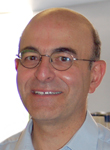
Sergio Pellegrino is the Joyce and Kent Kresa Professor of Aeronautics and Professor of Civil Engineering at the California Institute of Technology. He is also a Senior Research Scientist at Jet Propulsion Laboratory.
Professor Pellegrino's research focuses on lightweight structures and particularly on problems involving packaging, deployment, shape control and stability.
See website: http://pellegrino.caltech.edu/index.html

Sergio Pellegrino is the Joyce and Kent Kresa Professor of Aeronautics and Professor of Civil Engineering at the California Institute of Technology. He is also a Senior Research Scientist at Jet Propulsion Laboratory.
Professor Pellegrino's research focuses on lightweight structures and particularly on problems involving packaging, deployment, shape control and stability.
See website: http://pellegrino.caltech.edu/index.html
Mark Schenk
Origami in Deployable Structures for Small Satellites
The key challenge of deployable space structures is developing a method to compactly fold the structure during launch, before unfurling it to its full dimensions once in space. In small satellites storage volume is at an even greater premium, requiring a very high packaging efficiency for the deployable structures. Engineering origami provides a potential solution to these demanding requirements.
This talk focuses on a CubeSat technology demonstration mission under development at the Surrey Space Centre. The primary satellite payload is an inflatable cylindrical mast, which is folded using an origami pattern. The trade-off leading to the use of origami folding, the selection of a suitable pattern, and the manufacturing challenges leading up to the testing of the inflatable boom will be discussed. Further applications of origami in deployable space structures for small satellites are briefly highlighted
The key challenge of deployable space structures is developing a method to compactly fold the structure during launch, before unfurling it to its full dimensions once in space. In small satellites storage volume is at an even greater premium, requiring a very high packaging efficiency for the deployable structures. Engineering origami provides a potential solution to these demanding requirements.
This talk focuses on a CubeSat technology demonstration mission under development at the Surrey Space Centre. The primary satellite payload is an inflatable cylindrical mast, which is folded using an origami pattern. The trade-off leading to the use of origami folding, the selection of a suitable pattern, and the manufacturing challenges leading up to the testing of the inflatable boom will be discussed. Further applications of origami in deployable space structures for small satellites are briefly highlighted
About Mark Schenk
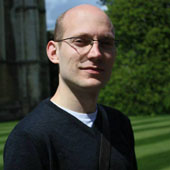
Mark Schenk is a research fellow in deployable structures at the Surrey Space Centre (UK).
See website: http:/www.markschenk.com/research/

Mark Schenk is a research fellow in deployable structures at the Surrey Space Centre (UK).
See website: http:/www.markschenk.com/research/
Tomohiro Tachi
Designing Stiff and Flexible Origami
Two of major approaches for applied origami in mechanical engineering are (a) to obtain stiff lightweight structures including folded plate shell structures, and sandwich panels with origami cores, and (b) to obtain flexible deployable mechanisms. Since the stiffness of type (a) structure is obtained when the boundary is closed to form cylinders or when each part is assembled and adhered to other sheets, the straightforward expectation is that the stiffness and the flexibility are mutually exclusive properties of origami.
However, recent studies on rigid origami, i. e., plate-and-hinge mechanisms, allow us to design deployable and yet stiff structures through the use of geometrically compatible rigid thick materials or foldable cylindrical and composite structures.
In this talk, the speaker introduces design methods for such stiff and flexible origami systems by producing statically indeterminate unstable structures.
Two of major approaches for applied origami in mechanical engineering are (a) to obtain stiff lightweight structures including folded plate shell structures, and sandwich panels with origami cores, and (b) to obtain flexible deployable mechanisms. Since the stiffness of type (a) structure is obtained when the boundary is closed to form cylinders or when each part is assembled and adhered to other sheets, the straightforward expectation is that the stiffness and the flexibility are mutually exclusive properties of origami.
However, recent studies on rigid origami, i. e., plate-and-hinge mechanisms, allow us to design deployable and yet stiff structures through the use of geometrically compatible rigid thick materials or foldable cylindrical and composite structures.
In this talk, the speaker introduces design methods for such stiff and flexible origami systems by producing statically indeterminate unstable structures.
About Tomohiro Tachi
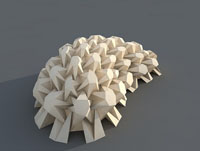
Freeform Origami Tessellation Designed by Generalization of Resch's Patterns
Tomohiro Tachi is an Assistant Professor of Graphics and Computer Sciences, at the University of Tokyo. He is a world renowned origami artist and researcher. His expertise is in architectural and computational origami, physics-based design, digital fabrication, kinetic structures and form finding methods for origami. Prof Tachi has developed a number of origami computational tools and has developed fundamental theory in the area of rigid folding.
See website: http://www.tsg.ne.jp/TT/index.html

Freeform Origami Tessellation Designed by Generalization of Resch's Patterns
Tomohiro Tachi is an Assistant Professor of Graphics and Computer Sciences, at the University of Tokyo. He is a world renowned origami artist and researcher. His expertise is in architectural and computational origami, physics-based design, digital fabrication, kinetic structures and form finding methods for origami. Prof Tachi has developed a number of origami computational tools and has developed fundamental theory in the area of rigid folding.
See website: http://www.tsg.ne.jp/TT/index.html
Sheng Xu
Flexible, Foldable and Stretchable Electronics
Wearable devices that match the soft, curvilinear, and time-dynamic nature of human body is an important trend for future technologies, redefining not only the appearance, but also the design and fabrication of microelectronics. In this talk, I will discuss the strategy to transform materials and devices that are conventionally rigid and brittle into a soft format. Specifically, the mechanical properties of rigid systems can be engineered by breaking down their geometry into small islands and subsequently rebuilding the interconnections with flexible/stretchable conducting filaments. This principle can be illustrated by two examples, which represent the latest progress in stretchable energy storage and mobile healthcare: a wirelessly rechargeable lithium ion battery with a record reversible biaxial stretchability up to 300%, and a soft wearable system capable of multifunctional physiological sensing on skin for health monitoring.
Wearable devices that match the soft, curvilinear, and time-dynamic nature of human body is an important trend for future technologies, redefining not only the appearance, but also the design and fabrication of microelectronics. In this talk, I will discuss the strategy to transform materials and devices that are conventionally rigid and brittle into a soft format. Specifically, the mechanical properties of rigid systems can be engineered by breaking down their geometry into small islands and subsequently rebuilding the interconnections with flexible/stretchable conducting filaments. This principle can be illustrated by two examples, which represent the latest progress in stretchable energy storage and mobile healthcare: a wirelessly rechargeable lithium ion battery with a record reversible biaxial stretchability up to 300%, and a soft wearable system capable of multifunctional physiological sensing on skin for health monitoring.
About Sheng Xu
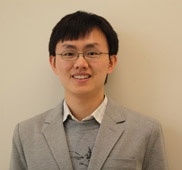
Sheng Xu is currently a postdoctoral research associate at the University of Illinois Urbana-Champaign, where he is working with professor John Rogers on stretchable electronic devices.
See website: http://publish.illinois.edu/shengxu/

Sheng Xu is currently a postdoctoral research associate at the University of Illinois Urbana-Champaign, where he is working with professor John Rogers on stretchable electronic devices.
See website: http://publish.illinois.edu/shengxu/
Zhong You
Crashworthy Origami Structures
In recent decades origami folding, an art form of paper folding, has been of increasing interest to both mathematicians and engineers. Mathematicians are more interested in the geometrical aspects of origami objects such as foldability of origami patterns, especially foldability of developable surfaces. Engineers, on the other hand, are finding that traditional geometry and folding used for artistic paper models can be readily parameterised and applied to the development of new structures and devices. Since most of the sheet materials used in engineering applications are relatively rigid in comparison with paper, particular attention has been drawn on to rigid origami, a subset of origami that permit continuous motion between folded states along the pre-determined folding creases without the need for twisting or stretching of the facets. This allows the patterns to be readily manufactured from modern materials such as plastic, metal, or carbon-fibre sheets, producing patterns that are sufficiently strong and durable to be of use in large-scale applications.
The primary focus of my research is on the development of thin-walled energy absorbing structures using origami, including crash boxes and sandwich plates and shells containing origami core structures, also known as foldcores. This type of structures can be used in cars, helicopters and trains to absorb kinetic energy in case of a collision. It has been discovered that by pre-folding the surface of a thin-walled materials with particular sets of origami patterns, it is possible to alter the post-buckling failure mode, and this deformation mode could be tailored to coincide with very high energy absorption capability. For instance, the origami crash box that I developed exhibits 56% higher energy absorption ability in comparison with that of the conventional crash boxes of same weight. This approach has opened up many opportunities for developing innovative crashworthy structures.
In the lecture, I shall introduce a number of new structural concepts that have been developed by my research group. This family of structures can potentially be used in packaging, aircraft and military structures, e.g., barriers and shields, that are subjected to impact loadings.
In recent decades origami folding, an art form of paper folding, has been of increasing interest to both mathematicians and engineers. Mathematicians are more interested in the geometrical aspects of origami objects such as foldability of origami patterns, especially foldability of developable surfaces. Engineers, on the other hand, are finding that traditional geometry and folding used for artistic paper models can be readily parameterised and applied to the development of new structures and devices. Since most of the sheet materials used in engineering applications are relatively rigid in comparison with paper, particular attention has been drawn on to rigid origami, a subset of origami that permit continuous motion between folded states along the pre-determined folding creases without the need for twisting or stretching of the facets. This allows the patterns to be readily manufactured from modern materials such as plastic, metal, or carbon-fibre sheets, producing patterns that are sufficiently strong and durable to be of use in large-scale applications.
The primary focus of my research is on the development of thin-walled energy absorbing structures using origami, including crash boxes and sandwich plates and shells containing origami core structures, also known as foldcores. This type of structures can be used in cars, helicopters and trains to absorb kinetic energy in case of a collision. It has been discovered that by pre-folding the surface of a thin-walled materials with particular sets of origami patterns, it is possible to alter the post-buckling failure mode, and this deformation mode could be tailored to coincide with very high energy absorption capability. For instance, the origami crash box that I developed exhibits 56% higher energy absorption ability in comparison with that of the conventional crash boxes of same weight. This approach has opened up many opportunities for developing innovative crashworthy structures.
In the lecture, I shall introduce a number of new structural concepts that have been developed by my research group. This family of structures can potentially be used in packaging, aircraft and military structures, e.g., barriers and shields, that are subjected to impact loadings.
About Professor Zhong You
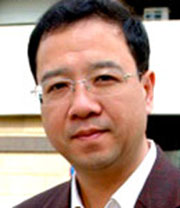
Zhong You is an associate professor in the department on Engineering Science at the University of Oxford.
See website: http://www-civil.eng.ox.ac.uk/people/zy/index.html

Zhong You is an associate professor in the department on Engineering Science at the University of Oxford.
See website: http://www-civil.eng.ox.ac.uk/people/zy/index.html
Yihui Zhang
Fractal-inspired interconnect designs for stretchable/foldable batteries and soft device systems
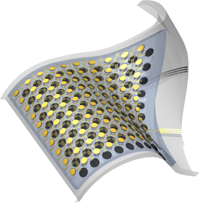 Schematic of the stretchable lithium ion battery.
Schematic of the stretchable lithium ion battery.
An important trend in electronics involves the development of materials, mechanical designs and manufacturing strategies that enable the use of unconventional substrates, such as polymer films, metal foils, paper sheets or rubber slabs. The last possibility is particularly challenging because the systems must accommodate not only bending but also stretching, sometimes to high levels of strain (>100%). Although several approaches are available for the electronics, a persistent difficulty is in energy storage devices and power supplies that have similar mechanical properties, to allow their co-integration with the electronics. Here, we introduce a set of materials and design concepts for a rechargeable lithium ion battery technology that exploits thin, low modulus, silicone elastomers as substrates, with a segmented design of the active materials, and unusual fractal inspired interconnect structures. The result enables reversible levels of stretchability up to 300%, while maintaining capacity densities of ~1.1 mAh/cm2. The fractal inspired interconnects are also exploited, together with the idea of soft microfluidics and structured adhesive surfaces, to achieve ultralow modulus, highly stretchable systems that incorporate assemblies of high modulus, rigid, state-of-the-art functional elements. The outcome is a thin, conformable device technology that can softly laminate onto the surface of the skin, to enable advanced, multifunctional operation for physiological monitoring in a wireless mode.
 Schematic of the stretchable lithium ion battery.
Schematic of the stretchable lithium ion battery.
About Yihui Zhang
Yihui Zhang is postdoctoral researcher at Northwestern University in Evanston, Illinois. He works with Professor Yonggang Huang to develop mechanics theory and novel designs of stretchable/flexible electronics, and soft robotics.
Link to video introducing stretchable lithium-ion batteries
Yihui Zhang is postdoctoral researcher at Northwestern University in Evanston, Illinois. He works with Professor Yonggang Huang to develop mechanics theory and novel designs of stretchable/flexible electronics, and soft robotics.
Link to video introducing stretchable lithium-ion batteries
Ilesanmi Adesida

Vice Chancellor for Academic Affairs and Provost Ilesanmi Adesida is the University of Illinois at Urbana-Champaign’s chief academic officer. He oversees the campus’ academic programs, policies and priorities, which have been designed to ensure the quality of the educational experience for students and to sustain an environment that encourages and supports academic excellence.
As the chief academic officer, Provost Adesida works closely with the Chancellor, the other vice chancellors, the deans of academic colleges and other units, academic staff, the Faculty Senate, and various committees in setting overall academic priorities for the campus.
He received his BS, MS, and PhD degrees in electrical engineering from the University of California, Berkeley. From 1979-84, he worked in various capacities at what is now known as the Cornell Nanofabrication Facility and the School of Electrical Engineering, Cornell University, Ithaca, NY. He was the head of the Electrical Engineering Department at Tafawa Balewa University, Bauchi, Nigeria, from 1985-87.
See website: http://provost.illinois.edu/about/staff/adesida/index.html
As the chief academic officer, Provost Adesida works closely with the Chancellor, the other vice chancellors, the deans of academic colleges and other units, academic staff, the Faculty Senate, and various committees in setting overall academic priorities for the campus.
He received his BS, MS, and PhD degrees in electrical engineering from the University of California, Berkeley. From 1979-84, he worked in various capacities at what is now known as the Cornell Nanofabrication Facility and the School of Electrical Engineering, Cornell University, Ithaca, NY. He was the head of the Electrical Engineering Department at Tafawa Balewa University, Bauchi, Nigeria, from 1985-87.
See website: http://provost.illinois.edu/about/staff/adesida/index.html
Charles J. Werth
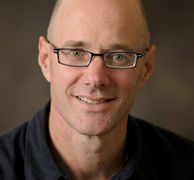
Charles J. Werth is a Professor, Associate Head for Graduate Affairs, Director of Research, and Arthur and Virginia Nauman Faculty Scholar in the Department of Civil and Environmental Engineering at the University of Illinois at Urbana-Champaign. He has been on the faculty since 1997.
Professor Werth holds a B.S. (Texas A&M University, 1988) degree in mechanical engineering, and M.S. (Stanford University, 1992) and Ph.D. (Stanford University, 1996) degrees in environmental engineering and science. He also holds a Ph.D. minor (Stanford University, 1996) in Chemistry.
Dr. Werth's research focuses on the transport and fate organic chemicals in the environment, and on the development of sustainable technologies for pollution abatement. Specific areas of interest include the study of reactive transport mechanisms of pollutants in porous media (with an emphasis on partitioning and mass transfer), development of catalytic reduction technologies for oxyanions and halogenated organics, and the fate of legacy/emerging pollutants in natural systems and engineered watersheds.
Professor Werth holds a B.S. (Texas A&M University, 1988) degree in mechanical engineering, and M.S. (Stanford University, 1992) and Ph.D. (Stanford University, 1996) degrees in environmental engineering and science. He also holds a Ph.D. minor (Stanford University, 1996) in Chemistry.
Dr. Werth's research focuses on the transport and fate organic chemicals in the environment, and on the development of sustainable technologies for pollution abatement. Specific areas of interest include the study of reactive transport mechanisms of pollutants in porous media (with an emphasis on partitioning and mass transfer), development of catalytic reduction technologies for oxyanions and halogenated organics, and the fate of legacy/emerging pollutants in natural systems and engineered watersheds.
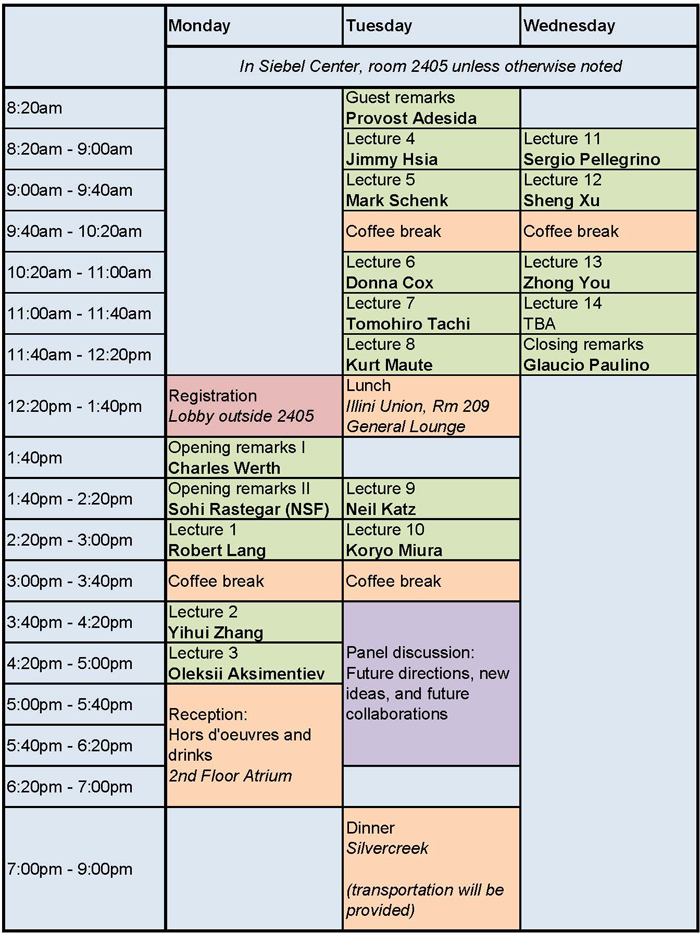
The event will be held from April 14-16th at the Siebel Center located on 201 N Goodwin Ave, Urbana, IL.
Accommodations will be provided at the nearby Hampton Inn Hotel located on 1200 W University Ave, Urbana, IL. Please contact workshop organizers with arrival and departure times to make travel arrangements.
Accommodations will be provided at the nearby Hampton Inn Hotel located on 1200 W University Ave, Urbana, IL. Please contact workshop organizers with arrival and departure times to make travel arrangements.
View 2014 Origami Engineering Workshop Map in a larger map

